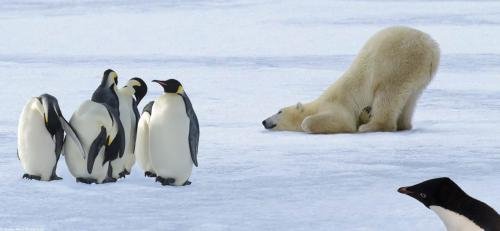In the vast icy expanses of our planet, two remarkable creatures inhabit opposite ends of the Earth: penguins in the South Pole and polar bears in the North Pole. While these two species may seem worlds apart, their relationship and coexistence reflect fascinating adaptations and the delicate balance of our planet's ecosystems.
The Contrasting Worlds:
Penguins and polar bears have adapted to their respective environments, developing remarkable traits and behaviors that enable them to survive in these extreme conditions. The South Pole, where penguins thrive, is a land of icy waters and frozen landscapes. In contrast, the North Pole is characterized by drifting ice and the icy waters of the Arctic Ocean, home to polar bears. These regions are distinct in terms of climate, geography, and the species that inhabit them.
Penguins (Spheniscidae): Masters of the Sea:
Penguins are flightless birds perfectly adapted to thrive in the Southern Hemisphere. Their streamlined bodies, waterproof feathers, and webbed feet make them excellent swimmers. With the ability to dive to impressive depths, penguins hunt for fish, squid, and krill in the cold Antarctic waters. These charismatic creatures form colonies on land, enduring the harsh Antarctic climate and relying on stable sea ice for their food chain.
Polar Bears (Ursus maritimus):
Kings of the Arctic: Polar bears, on the other hand, are the largest land predators on Earth, uniquely suited to life in the Arctic. With their thick white fur and layer of blubber, they are built to withstand the extreme cold. Their large paws and strong muscles make them formidable swimmers, essential for navigating the icy waters and hunting their primary prey, seals. The Arctic region provides a critical habitat for polar bears, as the sea ice serves as a platform for hunting, resting, and raising their young.
The Interconnectedness of Polar Environments: Although penguins and polar bears inhabit different poles, their existence is interconnected through the delicate balance of polar environments. The presence of sea ice in both regions influences ocean currents, regulates global climate patterns, and supports a diverse range of species. The melting of polar ice caps due to climate change poses a grave threat to these habitats. As ice coverage diminishes, both penguins and polar bears face challenges in hunting, breeding, and adapting to changing conditions.
Importance of Penguins and Polar Bears: Penguins and polar bears serve as vital indicators of the health of our planet's polar regions. Their presence reflects the richness and biodiversity of these unique ecosystems. By studying their behaviors, researchers gain insights into the effects of climate change and the overall well-being of the polar environment. Protecting these species is crucial not only for their survival but also for maintaining the intricate web of life in these fragile regions.
